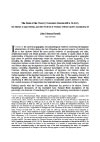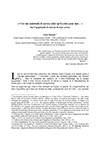Amenhotep II
« The Stela of the Viceroy Usersatet (Boston MFA 25.632), his Shrine at Qasr Ibrim, and the Festival of Nubian Tribute under Amenhotep II »
ENiM 7, 2014, p. 239-276.
 La stèle de Semna, du vice-roi de Nubie de la XVIIIe dynastie, Ousersatet, consigne un conseil donné par Amenhotep II à son vice-roi sous la forme d’une copie monumentale de la transcription personnelle du roi de son propre décret royal à Ousersatet. Le décret fut promulgué durant une fête célébrant l’accession royale, à une date secondaire, apparemment pour lier l’accession royale à la fête k?-?r-k?, à l’image de Ramsès III qui, plus tard, célébrera à la fois son accession et une fête de l’accession royale associée à la fête de Néhebkaou. Dans ce texte, Amenhotep II conseille Ousersatet quant aux interactions des Égyptiens et Nubiens avec l’administration du vice-roi et éclaire un peu les relations entre le roi, le vice-roi et les membres nubiens de la bureaucratie égyptienne du sud. La nature apparemment obscure et poétique du conseil royal et le manque de clarté quant à la situation d’Amenhotep II lorsqu’il le prodigue expliquent l’attention portée à ce texte, mais un certain manque de rigueur dans l’interprétation a obscurci plusieurs analyses de l’inscription. Un nouveau collationnement et un examen du texte de la stèle révèlent qu’Amenhotep II aborde apparemment la question de l’intégration croissante, par le vice-roi, de Nubiens dans les niveaux les plus élevés de l’administration du sud. Amenhotep II utilise une formule apparemment proverbiale qui fait référence à la transmission de l’autorité plus ancienne du vice-roi aux plus grandes divisions de la bureaucratie, et à la création d’un équivalent nubien du vice-roi, ce dernier restant néanmoins le primus inter pares de l’administration.
La stèle de Semna, du vice-roi de Nubie de la XVIIIe dynastie, Ousersatet, consigne un conseil donné par Amenhotep II à son vice-roi sous la forme d’une copie monumentale de la transcription personnelle du roi de son propre décret royal à Ousersatet. Le décret fut promulgué durant une fête célébrant l’accession royale, à une date secondaire, apparemment pour lier l’accession royale à la fête k?-?r-k?, à l’image de Ramsès III qui, plus tard, célébrera à la fois son accession et une fête de l’accession royale associée à la fête de Néhebkaou. Dans ce texte, Amenhotep II conseille Ousersatet quant aux interactions des Égyptiens et Nubiens avec l’administration du vice-roi et éclaire un peu les relations entre le roi, le vice-roi et les membres nubiens de la bureaucratie égyptienne du sud. La nature apparemment obscure et poétique du conseil royal et le manque de clarté quant à la situation d’Amenhotep II lorsqu’il le prodigue expliquent l’attention portée à ce texte, mais un certain manque de rigueur dans l’interprétation a obscurci plusieurs analyses de l’inscription. Un nouveau collationnement et un examen du texte de la stèle révèlent qu’Amenhotep II aborde apparemment la question de l’intégration croissante, par le vice-roi, de Nubiens dans les niveaux les plus élevés de l’administration du sud. Amenhotep II utilise une formule apparemment proverbiale qui fait référence à la transmission de l’autorité plus ancienne du vice-roi aux plus grandes divisions de la bureaucratie, et à la création d’un équivalent nubien du vice-roi, ce dernier restant néanmoins le primus inter pares de l’administration.
 The Semna stela of the Eighteenth Dynasty Viceroy of Nubia, Usersatet, records Amenhotep II’s advice to his viceroy in the form of a monumental copy of the king’s personal transcription of his own royal decree to Usersatet. The decree was issued during a festival celebrating the royal accession on a secondary date, apparently in order to link the king’s accession to the k?-?r-k? festival, just as Ramesses III later would celebrate both his actual accession and a festival of royal accession associated with the Nehebkau festival. Amenhotep II offers advice to Usersatet regarding interactions of Egyptians and Nubians within the viceregal administration, and shed some light on the interactions of king, viceroy, and Nubian members of the Egyptian bureaucracy in the south. The seemingly obscure and poetic nature of the king’s advice, and the lack of clarity regarding the situation about which Amenhotep II offers his advice, have led to considerable modern attention to the text, but a certain looseness of interpretation has plagued many examinations of the inscription. A new collation of the stela, and an examination of the text, reveal that Amenhotep II was apparently addressing the viceroy’s increasing integration of Nubians into the higher levels of the southern administration. Amenhotep II quotes an apparently proverbial saying that refers to a devolution of earlier viceregal authority into greater divisions of bureaucracy, and the creation of a Nubian counterpart to the viceroy, the latter remaining nevertheless the primus inter pares of the administration.
The Semna stela of the Eighteenth Dynasty Viceroy of Nubia, Usersatet, records Amenhotep II’s advice to his viceroy in the form of a monumental copy of the king’s personal transcription of his own royal decree to Usersatet. The decree was issued during a festival celebrating the royal accession on a secondary date, apparently in order to link the king’s accession to the k?-?r-k? festival, just as Ramesses III later would celebrate both his actual accession and a festival of royal accession associated with the Nehebkau festival. Amenhotep II offers advice to Usersatet regarding interactions of Egyptians and Nubians within the viceregal administration, and shed some light on the interactions of king, viceroy, and Nubian members of the Egyptian bureaucracy in the south. The seemingly obscure and poetic nature of the king’s advice, and the lack of clarity regarding the situation about which Amenhotep II offers his advice, have led to considerable modern attention to the text, but a certain looseness of interpretation has plagued many examinations of the inscription. A new collation of the stela, and an examination of the text, reveal that Amenhotep II was apparently addressing the viceroy’s increasing integration of Nubians into the higher levels of the southern administration. Amenhotep II quotes an apparently proverbial saying that refers to a devolution of earlier viceregal authority into greater divisions of bureaucracy, and the creation of a Nubian counterpart to the viceroy, the latter remaining nevertheless the primus inter pares of the administration.
 Consulter cet article (40866) -
Consulter cet article (40866) -  Télécharger cet article au format pdf (21841)
Télécharger cet article au format pdf (21841)
« “C’est une multitude de navires-kftjw qu’il a faits pour moi...”. Sur l’égyptianitĂ© du bateau de type crĂ©tois »
ENiM 14, 2021, p. 75-89.
 « C’est une multitude de navires-kftjw qu’il a faits pour moi… ». Sur l’égyptianité du bateau de type crétois. Au sein du vocabulaire égyptien relatif au monde égéen, le bateau kftjw (i.e. « de type crétois » = BTC) est mentionné à trois reprises dans la documentation, sous les règnes de Thoutmosis III et celui de son fils et successeur, Amenhotep II. Néanmoins, leur signification est aujourd’hui toujours l’objet de débats. D’après les travaux antérieurs des égyptologues et égéanistes, elle pourrait désigner soit la destination du voyage, soit l’origine de la construction et/ou un port d’attache. La relecture de la documentation textuelle permet de démontrer que ces navires sont construits à l’égyptienne, en Égypte, par et pour des Égyptiens.
« C’est une multitude de navires-kftjw qu’il a faits pour moi… ». Sur l’égyptianité du bateau de type crétois. Au sein du vocabulaire égyptien relatif au monde égéen, le bateau kftjw (i.e. « de type crétois » = BTC) est mentionné à trois reprises dans la documentation, sous les règnes de Thoutmosis III et celui de son fils et successeur, Amenhotep II. Néanmoins, leur signification est aujourd’hui toujours l’objet de débats. D’après les travaux antérieurs des égyptologues et égéanistes, elle pourrait désigner soit la destination du voyage, soit l’origine de la construction et/ou un port d’attache. La relecture de la documentation textuelle permet de démontrer que ces navires sont construits à l’égyptienne, en Égypte, par et pour des Égyptiens.
 “It’s a multitude of Kftjw-ships that he made for me…”. On the Egyptianity of the Cretan type boat. Within the Egyptian vocabulary related to the Aegean world, the kftjw boat (i.e. “Cretan type” = CTB) is mentioned three times in the documentation during the reigns of Thutmose III and that of his son and successor, Amenhotep II. Nevertheless, its meaning remains controversial. Earlier Egyptologists and Aegeanists scholars interpreted the term either as an indication of the ship’s destination, the origin of its construction or its home port. A reassessment of the textual documentation, however, demonstrates that these ships were built in Egypt, in the Egyptian way, by and for Egyptians.
“It’s a multitude of Kftjw-ships that he made for me…”. On the Egyptianity of the Cretan type boat. Within the Egyptian vocabulary related to the Aegean world, the kftjw boat (i.e. “Cretan type” = CTB) is mentioned three times in the documentation during the reigns of Thutmose III and that of his son and successor, Amenhotep II. Nevertheless, its meaning remains controversial. Earlier Egyptologists and Aegeanists scholars interpreted the term either as an indication of the ship’s destination, the origin of its construction or its home port. A reassessment of the textual documentation, however, demonstrates that these ships were built in Egypt, in the Egyptian way, by and for Egyptians.
 Consulter cet article (38554) -
Consulter cet article (38554) -  Télécharger cet article au format pdf (16493)
Télécharger cet article au format pdf (16493)
ENiM 18 - 2025
4 article(s) - 11 mars 2025.
ENiM 1 à 18 (2008-2025) : 223 articles
4 019 427 téléchargements
8 332 228 consulations.
Index des auteurs

Mots clés

Derniers articles : 
Robert Steven Bianchi
Duplication and Continuity
(ENiM 18, p. 13-36 — 11 mars 2025) 
Frédéric Mougenot
Rénénoutet à la porte de la maison
(ENiM 18, p. 1-12 — 29 janvier 2025) 
CENiM - Mise en ligne des volumes Ă©puisĂ©s : 
 Anne-Sophie von BOMHARD DĂ©cans Ă©gyptiens, CENiM 23, Montpellier, 2020 — (2020)
Anne-Sophie von BOMHARD DĂ©cans Ă©gyptiens, CENiM 23, Montpellier, 2020 — (2020) 
 Jean-Claude Grenier L'Osiris ANTINOOS, CENiM 1, Montpellier, 2008 — (26 dĂ©cembre 2008)
Jean-Claude Grenier L'Osiris ANTINOOS, CENiM 1, Montpellier, 2008 — (26 dĂ©cembre 2008) 
TDENiM - Mise en ligne des volumes Ă©puisĂ©s : 
 Twitter
Twitter 3615194 visites - 4694 visite(s) aujourd’hui - 194 connecté(s)
© ENiM - Une revue d’égyptologie sur internet
Équipe Égypte Nilotique et Méditerranéenne - UMR 5140 - « Archéologie des Sociétés Méditerranéennes » (Cnrs) - Université Paul Valéry - Montpellier III























 Contact
Contact
 Abonnez-vous !
Abonnez-vous ! Équipe Égypte Nilotique et Méditerranéenne
Équipe Égypte Nilotique et Méditerranéenne UMR 5140 « Archéologie des Sociétés Méditerranéennes » (Cnrs)
UMR 5140 « Archéologie des Sociétés Méditerranéennes » (Cnrs) Université Paul Valéry - Montpellier III
Université Paul Valéry - Montpellier III